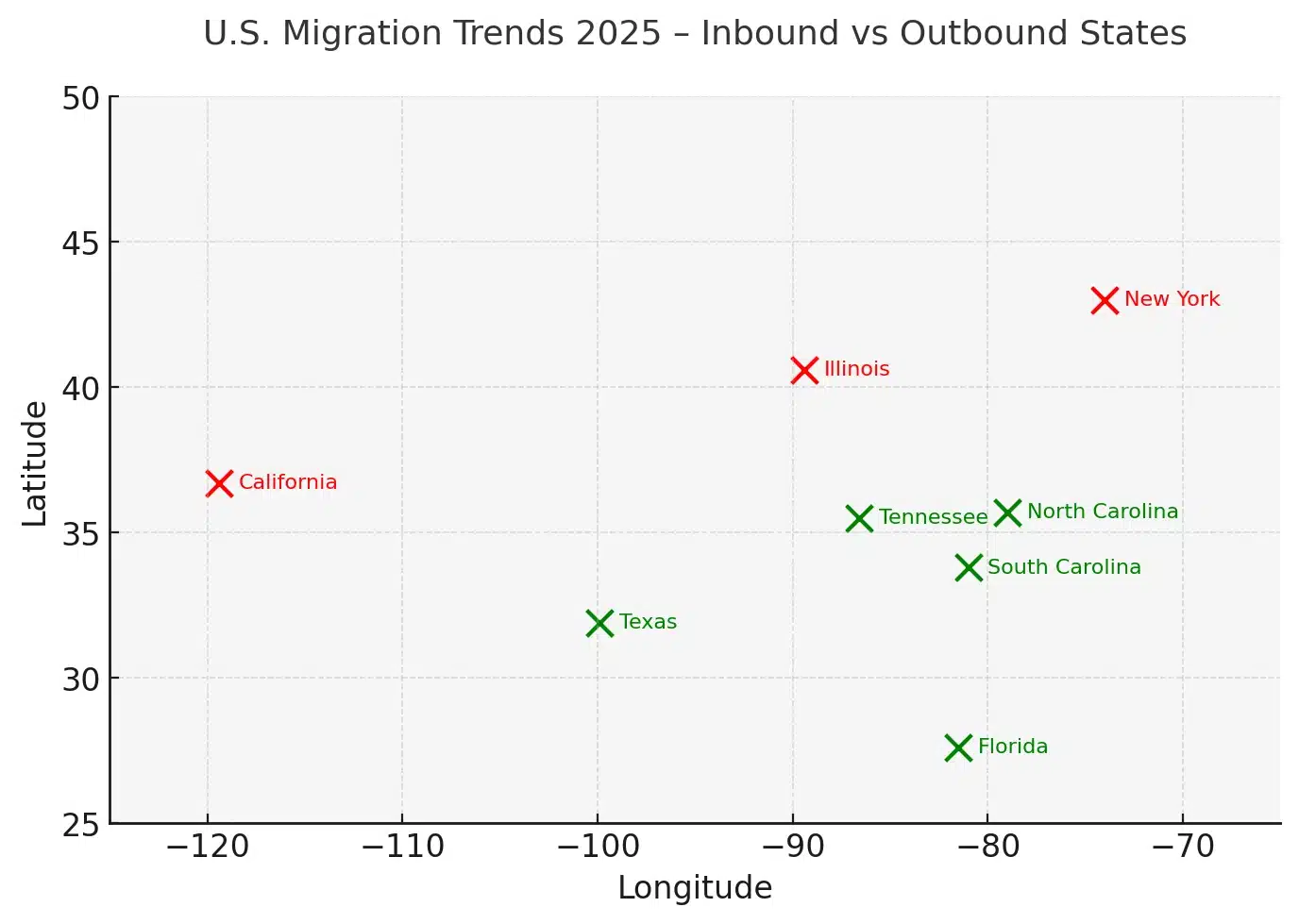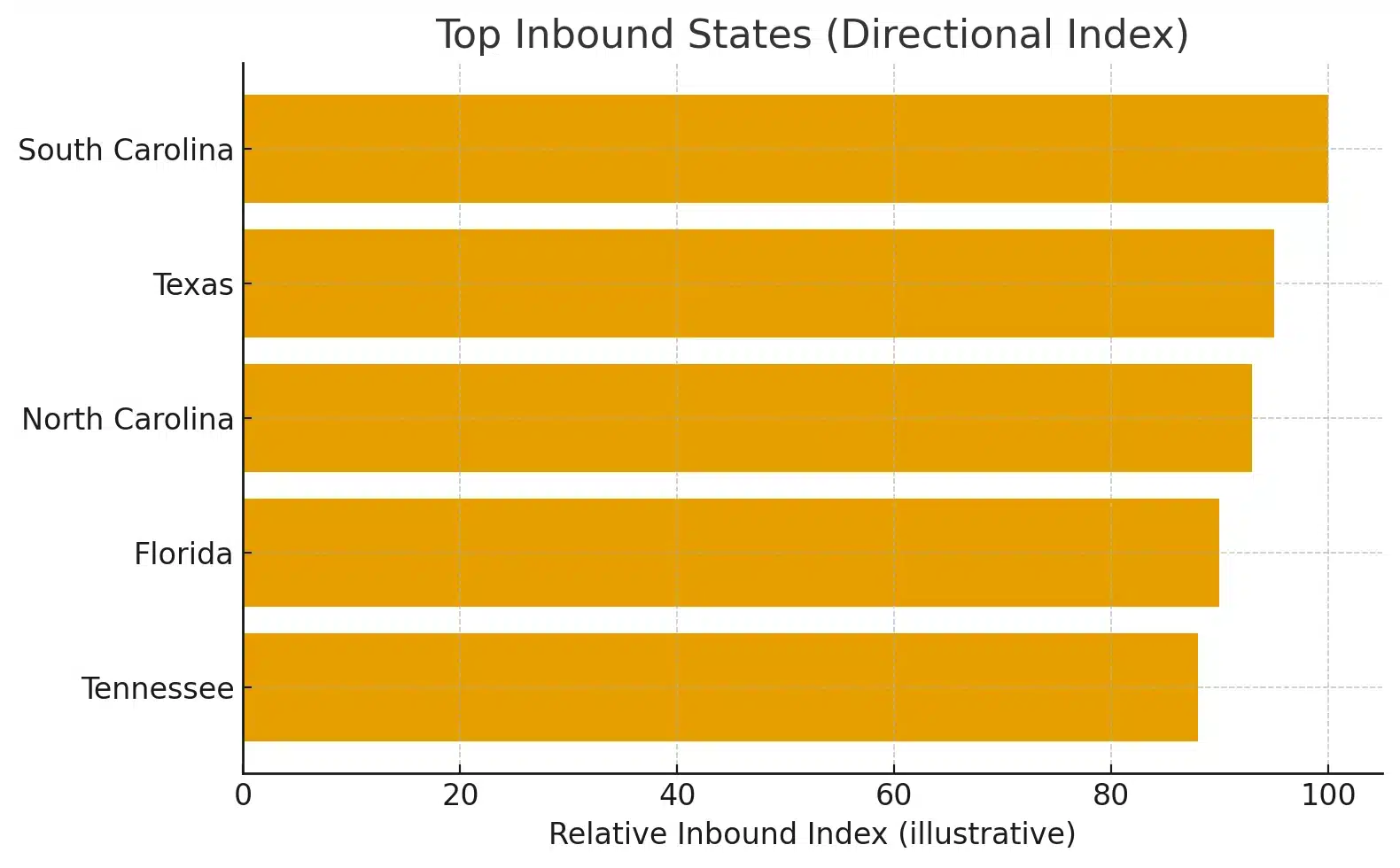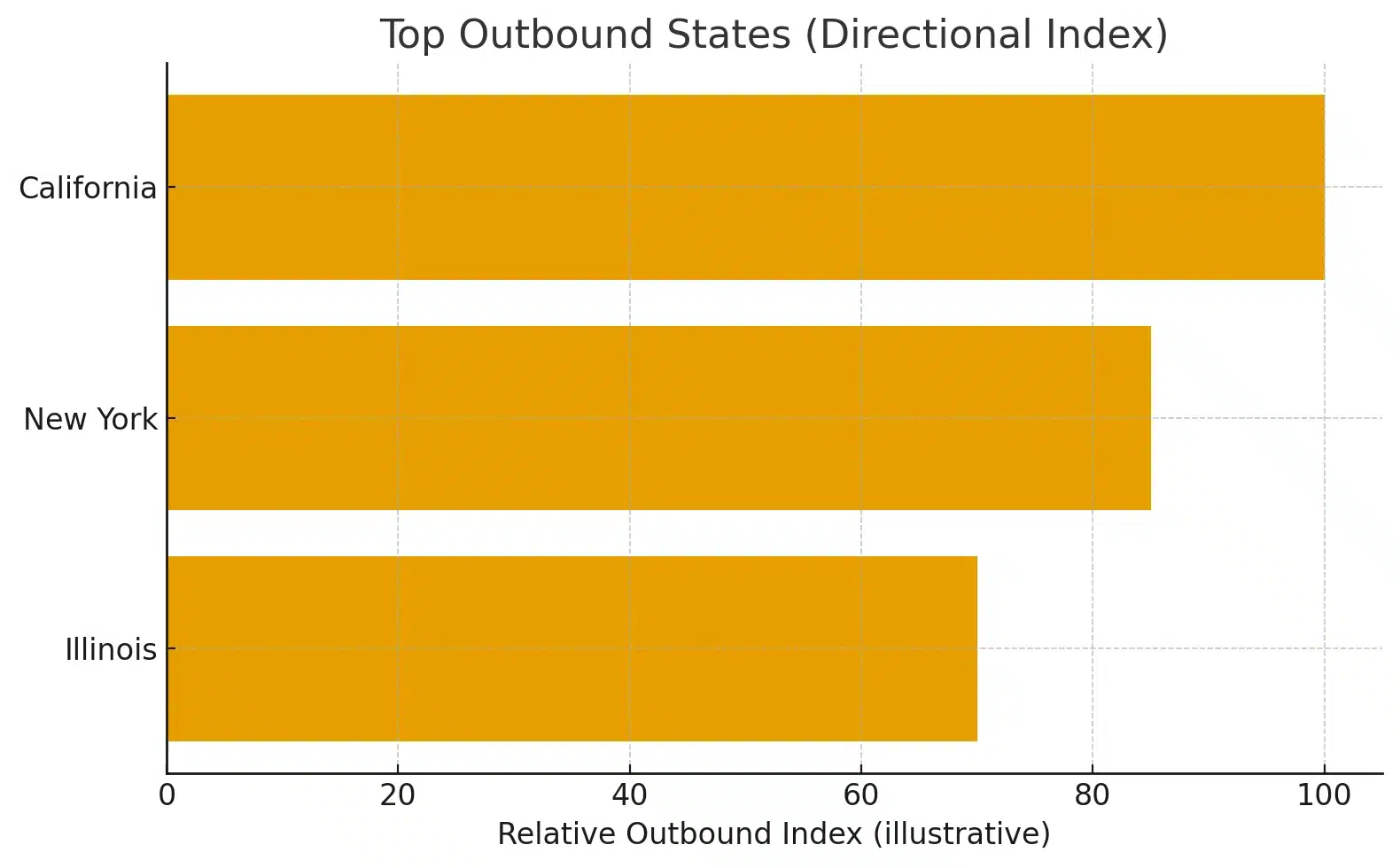2025 Outlook
Moving Trends & Migration Patterns in 2025: Where Are People Actually Going?
Multiple datasets indicate a consistent trend for 2024→2025: the Southeast and broader Sun Belt continue to attract new residents, while several West Coast and Northeastern states experience net out-migration.

Download the PDF Report
Share a concise and accurate summary of the 2025 migration trends with your team or clients.
2025 Snapshot: What’s Hot vs. Not
- Inbound momentum: South Carolina, Texas, North Carolina, Florida, Tennessee.
- Persistent outflows: California, New York, Illinois.
- Why it matters: Affordability, job growth, new housing supply, and lifestyle are still the key magnets.


How to Read the Different Datasets
U-Haul reflects millions of one-way DIY rentals (great for early directional signals). United Van Lines reports inbound/outbound shares for full-service relocations. Census is the official source for net domestic migration and population change. PODS emphasizes city-level momentum from container moves.Planning a Move Based on 2025 Trends
- Book earlier for high-demand Sun Belt destinations.
- Leaving a high-outflow state? Expect better mover availability and sometimes more flexible pricing.
- Lock in housing and mover dates early once you’ve identified target metros and timelines.
Top Residential Moving Trends in 2025
1. The Southeast Keeps Growing
The Carolinas, Tennessee, Georgia, and Texas remain the top relocation destinations in 2025. Affordable housing, job opportunities, and a better quality of life continue to pull residents from high-cost states like California, New York, and Illinois.
Inbound leaders: North Carolina, South Carolina, Tennessee
Outbound leaders: California, New York, New Jersey, Illinois
2. Suburbs Outshine Big Cities
Major metros like Los Angeles, San Francisco, and New York still see net population losses. Meanwhile, mid-size cities such as Raleigh, Charlotte, and Nashville are thriving. Many movers are choosing suburban areas with more space, better schools, and lower living costs — a trend that began during the pandemic and shows no sign of slowing down.
3. Affordability Is King
Housing costs remain the number one reason people move. Mortgage rates are still high, and renters are chasing value in lower-cost markets. States like Tennessee and Texas, with no state income tax and affordable real estate, are clear winners.
4. Remote Work Still Matters
Even with some companies calling employees back to the office, millions of Americans continue to enjoy location flexibility. This freedom allows people to move for lifestyle, family, and climate rather than just for work.
5. Climate Risks Are Changing Habits
Rising insurance premiums and disaster risks in California and Florida are pushing residents inland. Safer, more stable regions — like the Appalachian Mountains and parts of the Midwest — are seeing increased attention as “climate havens.”
Commercial Relocation Trends in 2025
1. Corporate Moves Shift South
The corporate migration boom has cooled slightly since its 2021–2023 peak, but the direction remains the same: business-friendly states are winning.
Texas leads the pack, followed by Florida, Tennessee, and North Carolina. These states continue attracting headquarters and branch offices thanks to lower taxes and an affordable workforce.
2. Office Space Redefined
Hybrid work has permanently reshaped office demand. Some companies are expanding high-quality spaces to entice workers back, while others are downsizing or moving to suburban office parks. Expect continued growth in flexible and shared workspaces in 2026.
3. Industrial and Logistics Growth
E-commerce, reshoring, and supply chain diversification are fueling a warehouse and manufacturing boom across the Midwest and South. The “Battery Belt” — stretching from Michigan to Georgia — is leading this industrial revival.
How 2025 Compares to 2024
Florida cools off: After years of inbound growth, Florida’s insurance and hurricane challenges have slowed migration.
The Carolinas and Tennessee rise: Both states top inbound lists in 2025, attracting retirees and remote workers alike.
Corporate relocations normalize: Fewer headline HQ moves, but steady growth continues in southern markets.
Office strategies diverge: Some firms expand, others shrink — hybrid flexibility is now standard.
Mobility remains low: Only about 8% of Americans moved in 2025, one of the lowest rates on record.
Forecast: What to Expect in 2026
Looking ahead, expect 2026 to reinforce the same migration patterns, shaped by affordability, flexibility, and policy.
Residential: Continued population growth in affordable Sun Belt states, slower recovery for coastal metros.
Commercial: More corporate expansion in the South; steady demand for industrial and logistics facilities.
Economy: If mortgage rates fall, pent-up demand could unleash a moving surge.
Politics & Climate: Tax policies, insurance reform, and extreme weather will further influence migration choices.
FAQs: Moving Trends in 2025
Which states are gaining the most movers in 2025?
Which states are seeing out-migration?
Why do different sources disagree?
How can I use this data to plan my move?
Conclusion
The story of 2025 moving trends is one of balance and adaptation. Americans are seeking places that align with their budgets, lifestyles, and values — and businesses are following them. As we move into 2026, the South and interior states look poised to remain America’s growth engines.
Sources & Notes
- U-Haul Growth States (2024, released Jan 2025): directional index from one-way truck rentals.
- United Van Lines National Movers Study (2024): inbound/outbound shares for full-service moves.
- U.S. Census Bureau (Vintage 2024): official net domestic migration estimates (2023→2024).
- PODS Moving Trends (2025): city-level momentum from container moves.





